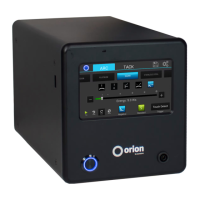Orion Pulse Arc Welding Workbook
10
TIPS WHEN RESISTANCE WELDING
With the above in mind there are several different helpful recommendations to use when resistance (Tack) welding.
• e pressure between the two parts is the most important variable in resistance welding; even the amount of energy
being used for the weld plays (to a degree) a lesser role.
• High pressure will create a cool weld.
• Light pressure will create a hot weld.
• No pressure will produce an arc!!
• Placing a small bump or weldment between difficult to weld parts can simplify the welding process.
If using tools to hold the workpieces remember that firm pressure between the tool and the workpiece is important to
prevent welding the tool to the workpiece (e.g. brass lined pliers). en apply the correct pressure between the workpieces
to achieve your weld.
HANDS ON: Try turning the Tack Mode energy to a middle setting and make a weld:
1. First weld with very firm pressure between the parts. e result may be little or no weld.
2. Next clamp the parts firmly in the tool but apply virtually no pressure between the parts (make sure these are parts
you no longer need). e result will be a very large spark, or at least a much better weld.
3. Practice at different energies and pressures until you feel comfortable with the process and results.
e pressure between the tool holding the part is also very important. If insufficient pressure
is applied between the tool and the part the weld may take place between the tool and the part.
Always grip the part firmly in the tool to reduce the contact resistance between the tool and
workpiece. Doing this will reduce the amount of heat created where the tool and part meet.
RESISTANCE WELDING TOOLS
It is always a good idea to have the resistance welding tool made from a material like copper (when welding more resistive
parts such as steels). If using a tool to hold the workpiece together remember that firm pressure between the tool and
the workpiece is important to prevent welding the tool to the workpiece (e.g. brass lined pliers). en apply the correct
pressure between the workpieces to achieve your weld. is will help to ensure the resistance between the tool and the
part is very low and no weld is made at this location.
Typically, steel is not used for resistance welding because of steel’s high internal resistance. is high resistance means
that a great deal of energy is dropped in the tool before even making it to the weld location. e tool can easily fuse to the
workpiece. e exception to making a resistance welding tool from steel is when only a small amount of energy is needed.
is may happen when only a light tack weld is needed before pulse arc welding.
CABLES FOR RESISTANCE WELDING
A true resistance welding hand piece should transfer as much energy to the weld location as possible. e Orion is capable
of transferring over 3000 amperes to the weld location.
TO ENABLE THIS FULL ENERGY TRANSFER:
1. e welding attachment should use 3.5ft (~1m) of 10AWG cable.
2. IMPORTANT the cable should be no larger than 10 AWG or damage to the welder may occur (e.g. 8AWG is a larger
cable).

